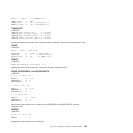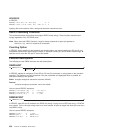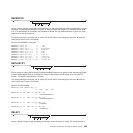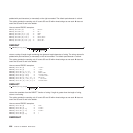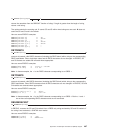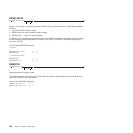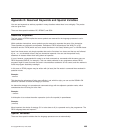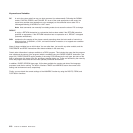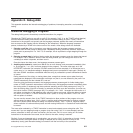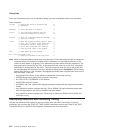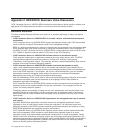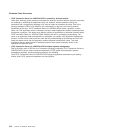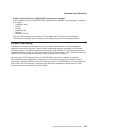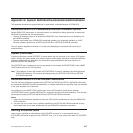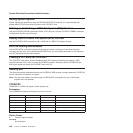
Appendix E. Debug Aids
This appendix describes the interactive debugging of problems, interrupting execution, and controlling
tracing.
Interactive Debugging of Programs
The debug facility permits interactively controlled execution of a program.
Changing the TRACE action to one with a prefix ? (for example, TRACE ?A or the TRACE built-in function)
turns on interactive debug and indicates to the user that interactive debug is active. Further TRACE
instructions in the program are ignored, and the language processor pauses after nearly all instructions
that are traced at the console (see the following for the exceptions). When the language processor
pauses, indicated by a READ in the lower corner of the screen, three debug actions are available:
1. Entering a null line (with no characters, even blanks) makes the language processor continue
execution until the next pause for debug input. Repeatedly entering a null line, therefore, steps from
pause point to pause point. For TRACE ?A, for example, this is equivalent to single-stepping through the
program.
2. Entering an equal sign (=) with no blanks makes the language processor rerun the clause last traced.
For example: if an IF clause is about to take the wrong branch, you can change the value of the
variable(s) on which it depends, and then rerun it.
Once the clause has been rerun, the language processor pauses again.
3. Anything else entered is treated as a line of one or more clauses, and processed immediately (that
is, as though DO; line; END; had been inserted in the program). The same rules apply as in the
INTERPRET instruction (for example, DO-END constructs must be complete). If an instruction has a
syntax error in it, a standard message is displayed and you are prompted for input again. Similarly all
the other SIGNAL conditions are disabled while the string is processed to prevent unintentional transfer
of control.
During execution of the string, no tracing takes place, except that nonzero return codes from host
commands are displayed. Host commands are always run (that is, are not affected by the prefix ! on
TRACE instructions), but the variable RC is not set.
Once the string has been processed, the language processor pauses again for further debug input
unless a TRACE instruction was entered. In this latter case, the language processor immediately alters
the tracing action (if necessary) and then continues executing until the next pause point (if any). To
alter the tracing action (from All to Results, for example) and then rerun the instruction, you must use
the built-in function TRACE (see page 195). For example, CALL TRACE I changes the trace action to I
and allows re-execution of the statement after which the pause was made. Interactive debug is turned
off, when it is in effect, if a TRACE instruction uses a prefix, or at any time when a TRACE O or TRACE
with no options is entered.
You can use the numeric form of the TRACE instruction to allow sections of the program to be run
without pause for debug input. TRACE n (that is, positive result) allows execution to continue, skipping
the next n pauses (when interactive debug is or becomes active). TRACE -n (that is, negative result)
allows execution to continue without pause and with tracing inhibited for n clauses that would otherwise
be traced.
The trace action selected by a TRACE instruction is saved and restored across subroutine calls. This
means that if you are stepping through a program (say after using TRACE ?R to trace Results) and then
enter a subroutine in which you have no interest, you can enter TRACE O to turn tracing off. No further
instructions in the subroutine are traced, but on return to the caller, tracing is restored.
Similarly, if you are interested only in a subroutine, you can put a TRACE ?R instruction at its start. Having
traced the routine, the original status of tracing is restored and (if tracing was off on entry to the
subroutine) tracing (and interactive debug) is turned off until the next entry to the subroutine.
© Copyright IBM Corp. 1992, 2009 411



